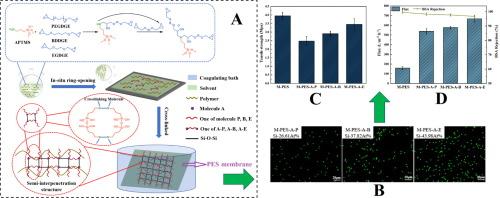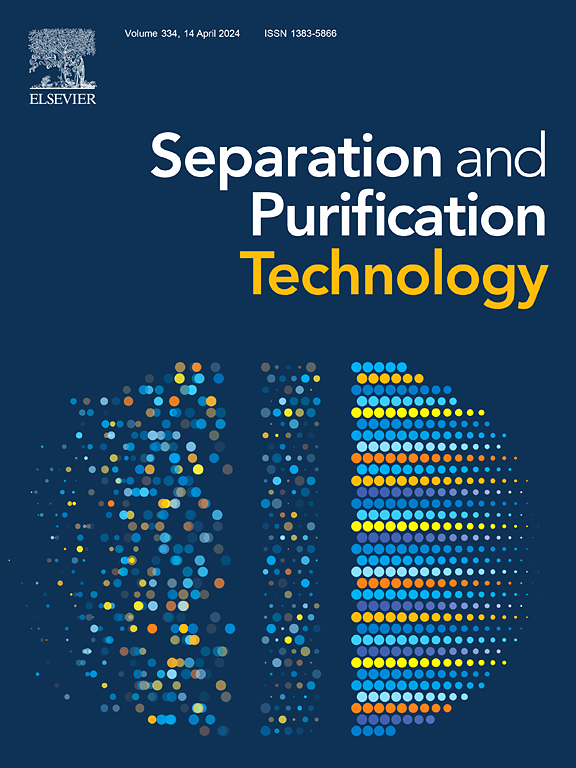The influence mechanism of cross-linking agent relative molecular mass on in-situ cross-linking in PES membrane matrix
IF 8.1
1区 工程技术
Q1 ENGINEERING, CHEMICAL
引用次数: 0
Abstract
In this paper, three cross-linking agents with varying relative molecular mass (RMM) were used to initiate in-situ cross-linking reaction in polyether sulfone (PES) membrane matrix, novel PES membranes were prepared through non-solvent induced phase separation (NIPS). Thereafter, the mechanism underlying cross-linking agent RMM’s influence on membrane structure and properties was analyzed. The results indicated that for the same proportion of dope solution system, cross-linking agents with smaller RMM will have more molar mass epoxy groups participating in the ring-opening reaction, which can form more hydroxyl groups in the subsequent cross-linking reaction, leading to a significant improvement in the hydrophilicity of PES membrane. Meanwhile, system with lower RMM of cross-linking agent had faster double diffusion rate in phase separation, and the larger most probable pore size formed in our modified membrane will further improve the permeation flux. The cross-linking network generated by the membrane formation system with low RMM of the cross-linking agent was more complete, and this modified membrane had a tensile strength maintained at 3.5Mpa. Relative to the original PES membrane, our optimal modified membrane has fourfold increased permeation flux, reaching 667.8 L·m−2·h−1. Meanwhile, BSA rejection of the membrane can be maintained at 96.7 %. Our modified membrane has improved antifouling efficiency, exhibiting persistent hydrophilicity during the 21-day washing experiment.


本文采用三种不同相对分子质量(RMM)的交联剂在聚醚砜(PES)膜基中引发原位交联反应,通过非溶剂诱导相分离(NIPS)制备了新型 PES 膜。随后,分析了交联剂 RMM 对膜结构和性能的影响机理。结果表明,在相同比例的掺杂溶液体系中,RMM 较小的交联剂会有更多摩尔质量的环氧基团参与开环反应,从而在后续的交联反应中形成更多的羟基,使 PES 膜的亲水性显著提高。同时,交联剂 RMM 较低的体系在相分离中的双重扩散速度更快,而改性膜形成的更大的最可能孔径将进一步提高渗透通量。交联剂 RMM 较低的成膜体系生成的交联网络更完整,改性膜的抗拉强度保持在 3.5 兆帕。与原始 PES 膜相比,我们的最佳改性膜的渗透通量提高了四倍,达到 667.8 L-m-2-h-1。同时,膜对 BSA 的排斥率可保持在 96.7%。我们的改性膜提高了防污效率,在 21 天的洗涤实验中表现出持久的亲水性。
本文章由计算机程序翻译,如有差异,请以英文原文为准。
求助全文
约1分钟内获得全文
求助全文
来源期刊

Separation and Purification Technology
工程技术-工程:化工
CiteScore
14.00
自引率
12.80%
发文量
2347
审稿时长
43 days
期刊介绍:
Separation and Purification Technology is a premier journal committed to sharing innovative methods for separation and purification in chemical and environmental engineering, encompassing both homogeneous solutions and heterogeneous mixtures. Our scope includes the separation and/or purification of liquids, vapors, and gases, as well as carbon capture and separation techniques. However, it's important to note that methods solely intended for analytical purposes are not within the scope of the journal. Additionally, disciplines such as soil science, polymer science, and metallurgy fall outside the purview of Separation and Purification Technology. Join us in advancing the field of separation and purification methods for sustainable solutions in chemical and environmental engineering.
 求助内容:
求助内容: 应助结果提醒方式:
应助结果提醒方式:


